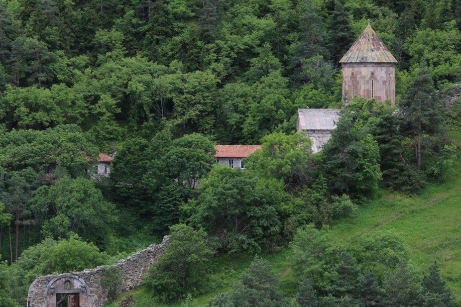New road gives access to Georgia’s Sapara medieval monastery

Travellers and locals looking to reach southern Georgia's medieval Sapara Monastery complex can now visit the site easier by travelling on a new, fully paved road .
Located near Ghreli village in Akhaltsikhe municipality, the historic complex is an important piece of the country's cultural legacy. Until now it has been difficult to access due to the unpaved road surface, which often turned into an unpassable muddy route in the rain.
Earlier today the Municipal Development Fund of Georgia announced work on the first ever tarmac road on a 7km road section leading to the Sapara complex.

Access to the complex was complicated due to the absence of a paved road. Photo from the Municipal Development Fund of Georgia.
Involving local workers in a 3.2 million GEL (about $1.3 million USD/£ 1 million*) project financed by the World Bank, the state agency said road markings, separators and other elements would soon be added to the newly road.
Built in the 9th Century AD, the Sapara Monastery complex included a fortress and served as the residence for the Jakeli noble family overseeing the Samktshe-Javakheti region of historical Georgia.
The complex includes the main church as well as smaller buildings for religious services and remains of a wall that once encircled the fortress.

The complex involves main church, smaller buildings and remains of a wall that once encircled the site. Photo from the Municipal Development Fund of Georgia.
The principal church building was subject to forceful modification and re-painting of its frescoes by 19th Century religious servants of the Russian Empire – during its annexation of Georgia - in attempts to make the monastery resemble the Russian church architectural style.
Works to conserve the monument were first launched in independent Georgia in 2008.
Works carried out by experts in subsequent years revealed unique frescoes and paintings under the covering layers of plain paint applied by Russian church workers. Historians and restoration professionals are still studying the frescoes discovered on the walls of the church.
* Currency rates are calculated using today's National Bank of Georgia exchange rate.
 Tweet
Tweet  Share
Share